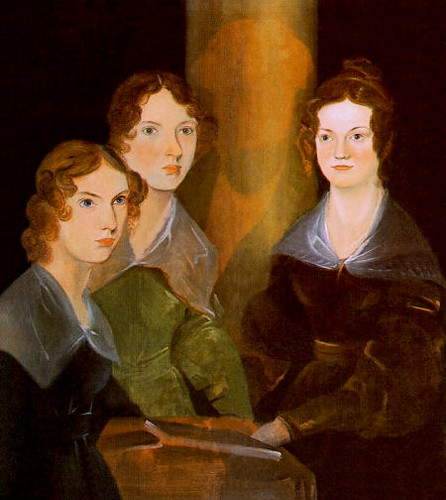No trembler in the world's storm-troubled sphere:
I see Heaven's glories shine,
And faith shines equal, arming me from fear...
There is not room for Death,
Nor atom that his might could render void:
Thou--THOU art Being and Breath,
And what THOU art may never be destroyed.
(read entirety)
(c. 1848. Believed to be Emily's final poem, it is said that Emily Dickinson chose this poem to be read at her own funeral.)

After the portrait by Branwell Brontë, c. 1833, in the National Portrait Gallery
Today marks 194 years since the birth of the indomitable Emily Brontë (July 30 1818 - December 19 1848). Wuthering Heights, her only published novel still continues to draw new generations of readers under its spell.
A creative genius, a girl of the Yorkshire moors who created some of the most detestable and compelling lovers in literature. The unique power of her works, is that it remains contemporary, and continues to inspire reinterpretations.
Wuthering Heights was written under the pseudonym Ellis Bell between October 1845 and June 1846, two years before her death and published in July 1847. It was not printed until December 1847, after the success of her sister Charlotte Brontë's novel Jane Eyre. A posthumous second edition of WH was edited by Charlotte in 1850.
I blogged about Emily on International Women's Day last year.

A mid-19th century portrait purporting to be of Emily Bronte (more info)
'Why, she's a liar to the end! Where is she? Not there — not in heaven — not perished—where? Oh! you said you cared nothing for my sufferings! And I pray one prayer—I repeat it till my tongue stiffens—Catherine Earnshaw, may you not rest as long as I am living; you said I killed you — haunt me, then! The murdered do haunt their murderers, I believe. I know that ghosts have wandered on earth. Be with me always — take any form—drive me mad! only do not leave me in this abyss, where I cannot find you! Oh, God! it is unutterable! I cannot live without my life! I cannot live without my soul!' (Chapter 16)

The most well known portrait of the sisters by their brother Branwell Brontë, c. 1835. Emily is on the left, behind Anne Sometimes referred to as 'The Pillar Portrait'.
Elizabeth Gaskell, Charlotte's biographer says of this portrait: "The picture was divided, almost in the middle, by a great pillar. On the side of the column which was lighted by the sun, stood Charlotte, in the womanly dress of that day of jigot sleeves and large collars. On the deeply shadowed side, was Emily, and Anne's gentle face resting on her shoulder. Emily's countenance struck me as full of power; Charlotte's of solicitude; Anne's of tenderness. The two younger seemed hardly to have attained their full growth, though Emily was taller than Charlotte; they had cropped hair, and a more girlish dress. I remember looking on those two sad, earnest, shadowed faces, and wondering whether I could trace the mysterious expression which is said to foretell an early death. I had some fond superstitious hope that the column divided their fates from hers, who stood apart in the canvas, as in life she survived. . . . They were good likenesses, however badly executed." (Gaskell, 'The Life of Charlotte Brontë', Ch.7)
Emily was also a poet, Poems by Currer, Ellis and Action Bell was published in 1846, containing twenty-one poems by Emily and by Anne and nineteen by Charlotte. Charlotte later revised and published some unseen poems of Emily's in 1850.

My first battered and mass produced Wordsworth Editions copy of 'Wuthering Heights'. I first read this when I was 10, but it only moved me inevitably when I was 16.
Read more:
Emily Brontë's poetry
Comprehensive Emily Brontë biography
Emily Brontë portrait goes under the hammer
Brontë Blog: To Emily on her birthday
Two portraits of Emily Brontë appear in 2011
I lingered round them, under that benign sky: watched the moths fluttering among the heath and harebells, listened to the soft wind breathing through the grass, and wondered how any one could ever imagine unquiet slumbers for the sleepers in that quiet earth. (Wuthering Heights, Chapter 34, closing lines.)

No comments:
Post a Comment